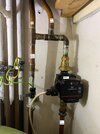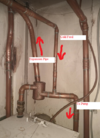I have an "S" plan open vent system newly flushed and new boiler, pump, etc etc replaced.
Normal pipe arrangement, one zone for central heating and one for the hot water.
All radiators and water HW tank heating fine BUT.....
Hot water is migrating up the F and E tank feed pipe. By this I mean the pipe which allows water from the tank to enter the system just before the pump.
This gradually makes and the water in the tank hot.
In turn this makes masses of condensation which finds its way into the overflow pipe and drips outside.
(Please note the system overflow pipe is fitted in the right place and is not blocked and hot water is not going up this into the tank. )
QUESTION : Can I safely put a non-return valve in the F and E tank feed pipe which allows water from the tank to enter the system so that cold tank water can run down from the tank but hot water cannot migrate up into the tank.
Normal pipe arrangement, one zone for central heating and one for the hot water.
All radiators and water HW tank heating fine BUT.....
Hot water is migrating up the F and E tank feed pipe. By this I mean the pipe which allows water from the tank to enter the system just before the pump.
This gradually makes and the water in the tank hot.
In turn this makes masses of condensation which finds its way into the overflow pipe and drips outside.
(Please note the system overflow pipe is fitted in the right place and is not blocked and hot water is not going up this into the tank. )
QUESTION : Can I safely put a non-return valve in the F and E tank feed pipe which allows water from the tank to enter the system so that cold tank water can run down from the tank but hot water cannot migrate up into the tank.



